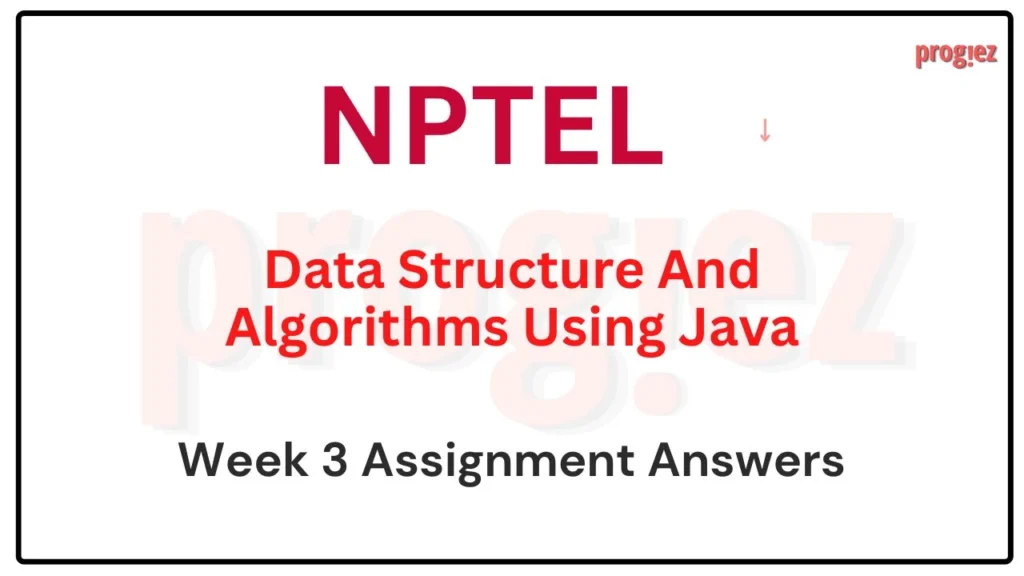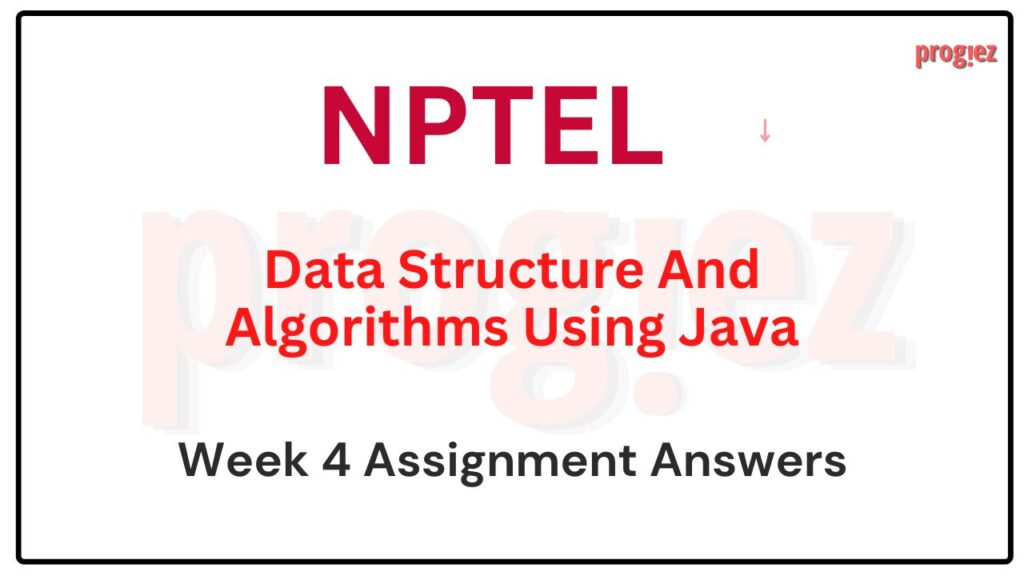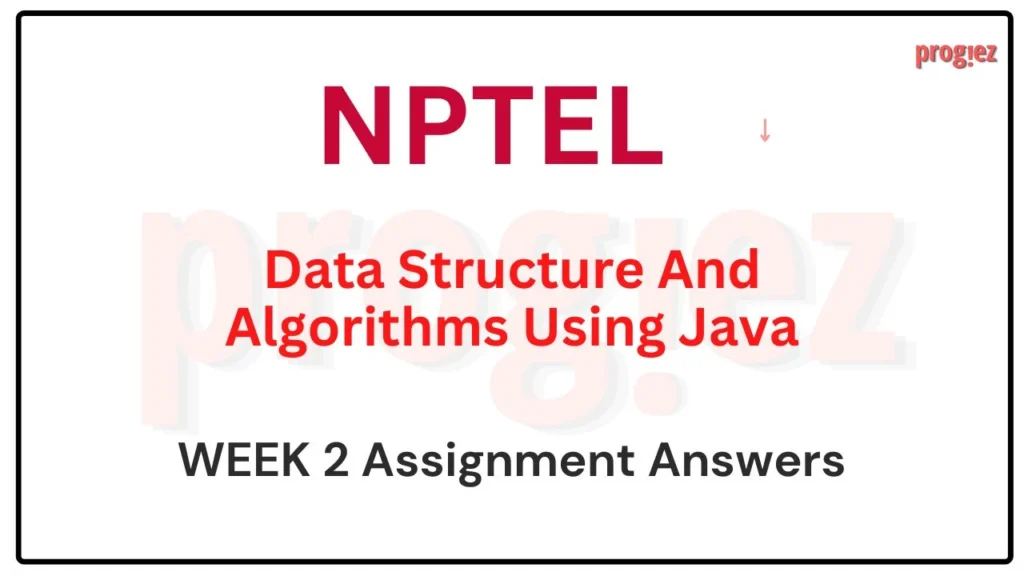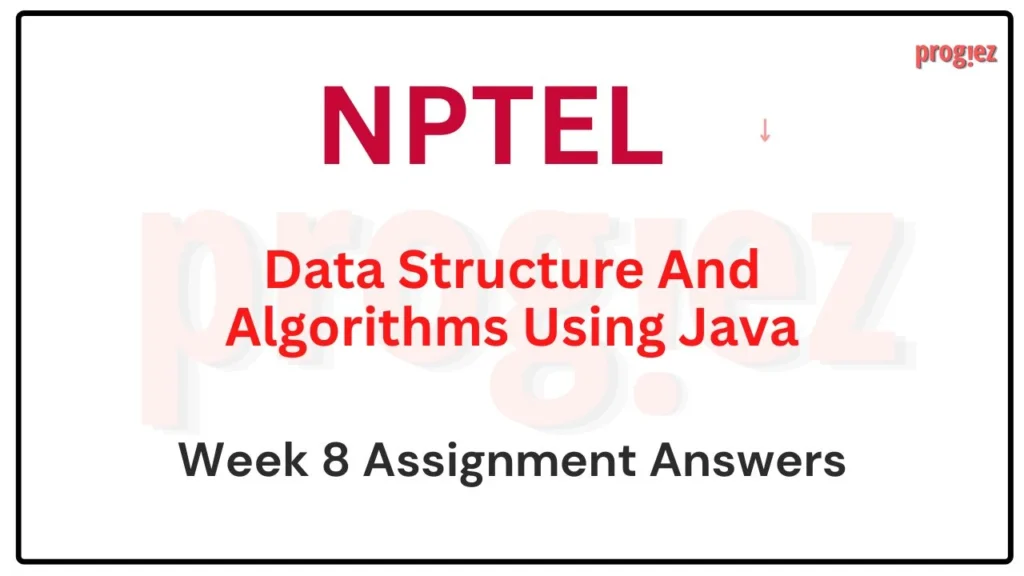Data Structure and Algorithms using Java Week 3 Nptel Answers
Are you looking for the Data Structure and Algorithms using Java Week 3 NPTEL Answers 2024 (July-Dec)? You’ve come to the right place! We provide accurate and detailed solutions to help you with your Week 4 assignments in this course.
Course Link: Click Here

Data Structure and Algorithms using Java Week 3 Nptel Answers
Session: JUL-DEC 2024
Q1.Which of the following statements about arrays in Java is true?
a. Arrays in Java are dynamic and can change their size after creation.
b. You can store different types of elements (e.g., integers and strings) in the same array in Java.
c. The default value of elements in an array of integers in Java is null.
d. The length of an array in Java can be determined using the length property.
Answer: d. The length of an array in Java can be determined using the length property.
Q2. Which of the following statements is true about the order of elements in the matrix array in Java?
a. Java stores 2D arrays in column-major order, so elements are stored column by column.
b. Java stores 2D arrays in row-major order, so elements are stored row by row.
c. Java allows you to specify whether a 2D array should be stored in row-major or column-major order.
d. Java does not support 2D arrays directly; it only supports arrays of arrays.
Answer: b. Java stores 2D arrays in row-major order, so elements are stored row by row.
For answers or latest updates join our telegram channel: Click here to join
These are Data Structure and Algorithms using Java Week 3 Nptel Answers
Q3. Which of the following is an output of the above program?
a. Charlie
b. Bob
c. Alice
d. Compilation Error
Answer: d. Compilation Error
Q4. Which of the following statements correctly declares an array in Java?
a. int[] numbers = new int();
b. int numbers[] = new int[10];
c. int numbers[10] = new int();
d. int numbers = new int[10]
Answer: b. int numbers[] = new int[10];
For answers or latest updates join our telegram channel: Click here to join
These are Data Structure and Algorithms using Java Week 3 Nptel Answers
Q5. Which of the following statements is true regarding ArrayList in Java?
a. ArrayList is a synchronized data structure, making it thread-safe.
b. ArrayList allows duplicate elements and maintains insertion order.
c. ArrayList has a fixed size that must be specified at creation and cannot be changed.
d. ArrayList can only store primitive data types like int, double, and char
Answer: b. ArrayList allows duplicate elements and maintains insertion order.
Q6.Which of the following is an output of the above program ?
a. It will print numbers from 1 to 5
b. It will print numbers from 1 to 5 and then throw an exception
c. It will compile but not run
d. It will not compile
Answer: b. It will print numbers from 1 to 5 and then throw an exception
For answers or latest updates join our telegram channel: Click here to join
These are Data Structure and Algorithms using Java Week 3 Nptel Answers
Q7.What would be the result of the following code?
import java.util.ArrayList;
public class ArrayListQuestion {
public static void main(String[] args) {
ArrayList<String> colors1 = new ArrayList<>();
colors1.add("red");
colors1.add("green");
colors1.add("blue");
colors1.add("yellow");
ArrayList<String> colors2 = new ArrayList<>(colors1);
colors2.add("orange");
colors2.add("purple");
colors2.add("pink");
System.out.println(colors2.get(5));
}}
a. It will print “purple”
b. It will print “pink”
c. It will print “green”
d. It will throw an exception
Answer: a. It will print “purple”
Q8.What will be the state of the ArrayList after executing the following code?
a. [apple, banana, elderberry, cherry]
b. [apple, banana, elderberry, cherry, date]
c. [apple, elderberry, banana, cherry, date]
d. [apple, banana, cherry, elderberry]
Answer: a. [apple, banana, elderberry, cherry]
For answers or latest updates join our telegram channel: Click here to join
These are Data Structure and Algorithms using Java Week 3 Nptel Answers
Q9.In Java, what is the average time complexity of adding an element to the end of an ArrayList and what is the worst-case time complexity of adding an element to the end of an ArrayList when it requires resizing??
a. Average: O(1), Worst-case: O(n)
b. Average: O(n), Worst-case: O(n log n)
c. Average: O(log n), Worst-case: O(n)
d. Average: O(1), Worst-case: O(1)
Answer: a. Average: O(1), Worst-case: O(n)
Q10.In Java, how can you search for the index of an element in an ArrayList named items and what is the time complexity of this operation?
a. Using items.get(element) with time complexity O(1)
b. Using items.indexOf(element) with time complexity O(n)
c. Using items.binarySearch(element) with time complexity O(log n)
d. Using items.find(element) with time complexity O(n log n)
Answer: b. Using items.indexOf(element) with time complexity O(n)
For answers or latest updates join our telegram channel: Click here to join
These are Data Structure and Algorithms using Java Week 3 Nptel Answers
Want all Weeks of Data Structure and Algorithms using Java Nptel Assignment Answers : Click here
For answers to additional Nptel courses, please refer to this link: NPTEL Assignment Answers





